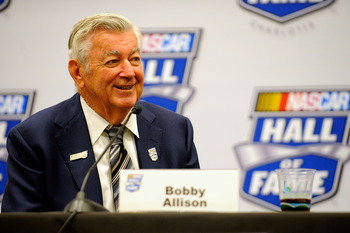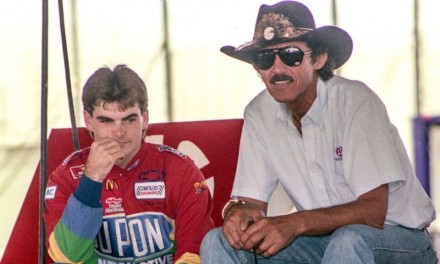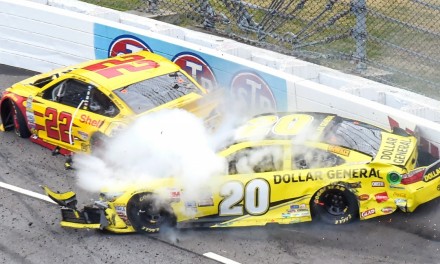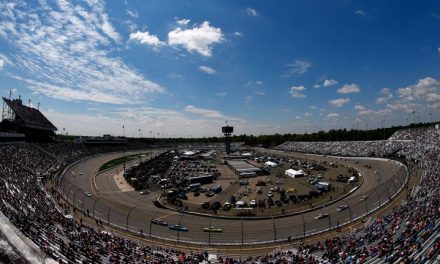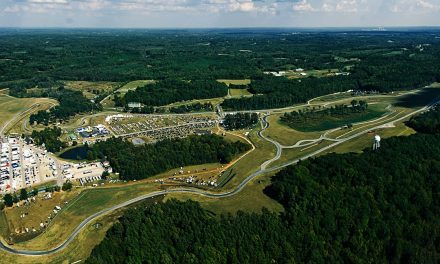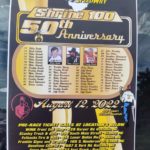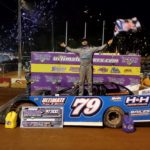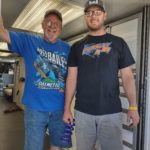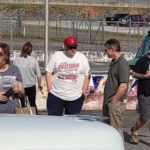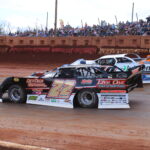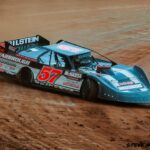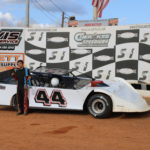By Patrick Reynolds
Bobby Allison’s win and championship statistics are easily accessible. Everything that qualified him for his NASCAR Hall of Fame honor can be researched. But like most spreadsheets, that list of winning numbers does not tell you about the man.
Allison was a successful short tracker who advanced to the Grand National Series. He was part of the generation that came up through grassroots racing, built their own cars and worked- literally worked- their way to the top.
When Allison met me for lunch in Mooresville, NC, where he now calls home, he appeared as if this was 40 years prior and he was taking a break from working in a shop instead of being a retired Hall of Famer. Dressed in blue work pants, and a tan button down shirt with a BA logo proudly showing, he looked like he could have just set down his tools from building a car.
Allison afforded me the privilege of sharing his thoughts on today’s short tracks and memories of his own Saturday night racing. We chatted over a typical short track meal, hot dogs. He looked, talked, and ate like what he has always been, a true racer.
Patrick Reynolds: Do you get to a lot of short tracks nowadays?
Bobby Allison: I go a little bit. Donnie’s boys do the Legacy (Series). Donnie’s one grandson (Justin) raced in the Legacy. Won several events. I watch him some.
I went and watched Hut’s boy, Taylor. Hut and Pam’s (Stricklin) son. Watched him run some short track racing.
PR: Other than your family, obviously, have any of the short track names stepped up and caught your eye?
BA: Actually, I got to say I’ve seen some and I’ve enjoyed some of it, but really haven’t paid close attention.
My one leftover from Pocono (crash, 1988) is I have really, really bad short-term retention. So I may see something that I enjoy or think is certainly worthy of me paying attention to and 10 minutes later I can’t remember a name. Rather than let it frustrate me, I said ‘That’s what I’ve got, I’ll do the best I can with it.’ I think that really helped me in my early recovery.
For a few months or a short period of time, it really troubled me every time I made any kind of mistake, came up short with I wanted to try to recall. One day I said ‘Well I’ll appreciate what I got. I’m not going to grieve over what I don’t have.’
I can remember (racing at Hialeah Speedway as a teenager) better than I can remember last week.
PR: When you were a regular on the Winston Cup circuit you used to go off during the week or to a local track when it was close by and race. Was that to make a living or for the love of the sport?
BA: It was a really great combination. I loved it and I did have success in so many places like that. But I was also able to get money to help promote my own efforts on the bigger tracks. In the earlier days I had to pay a lot of my own expenses. Even when I drove for some of the big hot dog outfits, I still ended up paying my own expenses and taking care of my own money. I needed to either get a better airplane or pay bills at home.
PR: As a driver what did you enjoy more, Grand National racing, or slipping off to a short track?
BA: As a driver I probably enjoyed the short tracks more. That’s a tough question for me, because I really, really, enjoyed the big tracks too. I looked forward to it and I got a lot of pleasure out of a win, or a good run. It didn’t have to be a win; it could just be a good run. Probably a slight edge has to go to the short tracks.
PR: Can you compare short track racing today to when you were racing?
BA: It certainly has escalated in terms of cost of the equipment and the attention. So many people have recognized that racing is a good, wholesome, healthy, enjoyable activity that more people are paying attention to it now.
And the equipment of course has come into the picture. Somebody goes a little bit faster and credits improved equipment to his own improvement and so everybody else feels like ‘Well I got to go get something or make something.’
You know, back in the early days, the individual made most of the equipment themselves. It was a little bit of speed equipment or race equipment available. Most of it you had to go figure out how to get a heavy-duty hub off of a three-quarter-ton pickup. And springs and shocks off of some vehicle at a better spring (rate) than what your original equipment had. Now you go buy it.
Way back in the old days when I discovered there was something I could buy that could help, I went ahead and begged, borrowed, and stole until I got enough to step up with the money and get what I needed.
Racing then didn’t have the safety equipment in the cars. So I think that definitely is an improvement for now. Worse then, better now. The equipment that was available, that was a tough deal in the early days. That’s a way better deal (today).
PR: Correct me if I’m wrong but, it seems to me that a driver is more willing to move a guy in front of him out of the way as opposed to just passing him today. That seems to be more prevalent. Has driver etiquette changed?
BA: That really was big early on. Pass a guy clean and it added a good value to a lot of people. I really felt that was the way it needed to be looked at. However, there were a time or two when I had to move somebody out of the way. But it wasn’t a deal where, as I got to him, they got moved out.
Probably the guy that did the most to change that in short track and big time racing was Dale Earnhardt. Boy, he was tough. He wanted to be your friend as long as you were standing there in the pits, but boy, I’m telling you what; he’d put that bumper on you friend or foe.
What happened was a certain part of the press glorified that. And then the next guy comes along and says ‘Well maybe I’ll give this guy a shot and reporter so-and-so will put a good word in the paper about me.’ There still is a lot of it there.
And we don’t know what this guy is hearing over the radio either. The spotter may be saying one thing and the car owner and chief mechanic, who also have radios, may be saying something else (laughing).
PR: Is there something short track promoters should be doing different today to bring the crowds back to the level they used to be?
BA: I wish I could give you that answer. I think what I would do right now is, I would go around and try to see these different places. And seeing what the promoters do and how they promote them. And how they treat the competitors. See if that makes a difference. See what the tracks themselves are. Really something that’s needed: give the people what they want to see.
Big tracks and Cup racing has put such a split between our hero local driver and the big guys that our hero local driver doesn’t get the attention he ought to get. And they seem to forget that today’s biggest hero did come from the short tracks somewhere.
PR: What are your thoughts on Richie Evans being inducted into the NASCAR Hall of Fame?
BA: Well, it has got to be a great plus for the deal, because when people come to the Hall of Fame to look, they certainly want to see the big time stuff. But part of what they want to see is ‘How did they get here?’ And Richie is a real good connection to how it went from the backyard to the Hall of Fame. So I’m very pleased to see him. And I think that as time goes on you will see a few more that came from the different divisions along the way. It was really an honor for me. It certainly has to be for anybody like that too. But also part of the honor is having people see what got you there.
PR: What advice could you give a young short tracker to move his career along?
BA: I say you have to give your best effort. You have to be satisfied you gave your best effort, no matter where you are. And see what you can do to improve it, and stay within the rules. My Dad’s biggest guidance to me from really early on to way on late in my career was, you’ve got to give your best effort everyday. Do the best you can everyday. Do it within the rules.
Patrick Reynolds is a former professional NASCAR mechanic who hosts Motor Week LIVE! Mondays 7pm ET/ 4pm PT onwww.racersreunionradio.com

